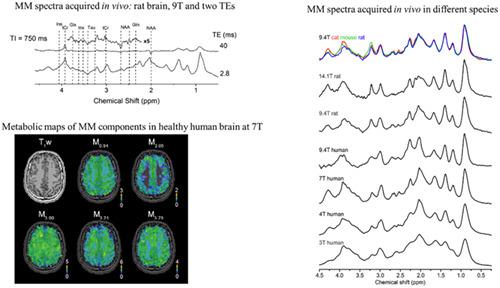当前位置:
X-MOL 学术
›
NMR Biomed.
›
论文详情
Our official English website, www.x-mol.net, welcomes your
feedback! (Note: you will need to create a separate account there.)
Contribution of macromolecules to brain 1H MR spectra: Experts' consensus recommendations
NMR in Biomedicine ( IF 2.7 ) Pub Date : 2020-11-25 , DOI: 10.1002/nbm.4393 Cristina Cudalbu 1 , Kevin L Behar 2 , Pallab K Bhattacharyya 3 , Wolfgang Bogner 4, 5 , Tamas Borbath 6, 7 , Robin A de Graaf 8 , Rolf Gruetter 9 , Anke Henning 6, 10 , Christoph Juchem 11 , Roland Kreis 12 , Phil Lee 13 , Hongxia Lei 1 , Małgorzata Marjańska 14 , Ralf Mekle 15 , Saipavitra Murali-Manohar 6, 7 , Michal Považan 16 , Veronika Rackayová 1, 9 , Dunja Simicic 1, 9 , Johannes Slotboom 17 , Brian J Soher 18 , Zenon Starčuk 19 , Jana Starčuková 19 , Ivan Tkáč 14 , Stephen Williams 20 , Martin Wilson 21 , Andrew Martin Wright 6, 22 , Lijing Xin 1 , Vladimír Mlynárik 4, 5
NMR in Biomedicine ( IF 2.7 ) Pub Date : 2020-11-25 , DOI: 10.1002/nbm.4393 Cristina Cudalbu 1 , Kevin L Behar 2 , Pallab K Bhattacharyya 3 , Wolfgang Bogner 4, 5 , Tamas Borbath 6, 7 , Robin A de Graaf 8 , Rolf Gruetter 9 , Anke Henning 6, 10 , Christoph Juchem 11 , Roland Kreis 12 , Phil Lee 13 , Hongxia Lei 1 , Małgorzata Marjańska 14 , Ralf Mekle 15 , Saipavitra Murali-Manohar 6, 7 , Michal Považan 16 , Veronika Rackayová 1, 9 , Dunja Simicic 1, 9 , Johannes Slotboom 17 , Brian J Soher 18 , Zenon Starčuk 19 , Jana Starčuková 19 , Ivan Tkáč 14 , Stephen Williams 20 , Martin Wilson 21 , Andrew Martin Wright 6, 22 , Lijing Xin 1 , Vladimír Mlynárik 4, 5
Affiliation

|
Proton MR spectra of the brain, especially those measured at short and intermediate echo times, contain signals from mobile macromolecules (MM). A description of the main MM is provided in this consensus paper. These broad peaks of MM underlie the narrower peaks of metabolites and often complicate their quantification but they also may have potential importance as biomarkers in specific diseases. Thus, separation of broad MM signals from low molecular weight metabolites enables accurate determination of metabolite concentrations and is of primary interest in many studies. Other studies attempt to understand the origin of the MM spectrum, to decompose it into individual spectral regions or peaks and to use the components of the MM spectrum as markers of various physiological or pathological conditions in biomedical research or clinical practice. The aim of this consensus paper is to provide an overview and some recommendations on how to handle the MM signals in different types of studies together with a list of open issues in the field, which are all summarized at the end of the paper.
中文翻译:

大分子对大脑 1H MR 波谱的贡献:专家的共识建议
大脑的质子 MR 光谱,尤其是在短回波时间和中间回波时间测量的那些,包含来自移动大分子 (MM) 的信号。本共识文件提供了主要 MM 的描述。MM 的这些宽峰是代谢物较窄峰的基础,通常会使它们的量化复杂化,但它们作为特定疾病的生物标志物也可能具有潜在的重要性。因此,从低分子量代谢物中分离广泛的 MM 信号能够准确测定代谢物浓度,并且是许多研究中的主要兴趣。其他研究试图了解 MM 光谱的起源,将其分解为单独的光谱区域或峰值,并将 MM 光谱的成分用作生物医学研究或临床实践中各种生理或病理状况的标记。
更新日期:2020-11-25
中文翻译:

大分子对大脑 1H MR 波谱的贡献:专家的共识建议
大脑的质子 MR 光谱,尤其是在短回波时间和中间回波时间测量的那些,包含来自移动大分子 (MM) 的信号。本共识文件提供了主要 MM 的描述。MM 的这些宽峰是代谢物较窄峰的基础,通常会使它们的量化复杂化,但它们作为特定疾病的生物标志物也可能具有潜在的重要性。因此,从低分子量代谢物中分离广泛的 MM 信号能够准确测定代谢物浓度,并且是许多研究中的主要兴趣。其他研究试图了解 MM 光谱的起源,将其分解为单独的光谱区域或峰值,并将 MM 光谱的成分用作生物医学研究或临床实践中各种生理或病理状况的标记。











































 京公网安备 11010802027423号
京公网安备 11010802027423号